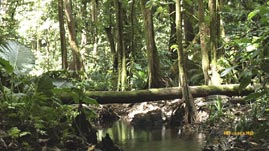Teachers' Domain - Digital Media for the Classroom and Professional Development
User: Preview

Source: Micronesia Conservation Trust
This video adapted from the Micronesia Conservation Trust features Kosrae’s pristine Yela watershed. With a variety of ecosystems from ridgetop to coral reef, the Yela watershed demonstrates how a healthy ecological relationship functions. Only pure, pollution-free water runs out to the ocean, and its Ka tree forest provides lumber for building houses and canoes. The Yela watershed is one of Micronesia’s best examples of ecosystem-based adaptation. Today, through an agreement called a conservation easement, thewatershed remains undeveloped so that it may continue to benefit Kosrae residents and the area’s future generations.
Vocabulary:
Over the last thousand years or more, human activities such as farming, raising livestock, and land development have transformed Pacific islands. Clearing trees and other native plants loosens the soil. As a result, a greater amount of sediment washes downstream when it rains. When the sediment finally reaches the ocean, it settles like a blanket over coral reefs and can kill corals, the animals that build reefs.
This video features the Yela watershed forest on the island of Kosrae in Micronesia. With its rare Ka tree forest, the Yela watershed is a great example of a healthy and resilient ecosystem. The upland forest, the freshwater swamp, the mangroves, and the coral reef all function together to ensure that only pure water runs out to the ocean. Healthy and resilient ecosystems benefit the organisms that live there and nearby human communities.
Kosrae uses ecosystem-based management to protect the Yela watershed. Scientists create maps and models to understand how changes in watersheds can affect coral reef systems. Island resource managers then use these tools to develop plans to make their watersheds more resilient.
Recognizing the importance of the Yela watershed ecosystem, environmental groups, the 10 families who own the land, and the Kosrae government partnered to protect the Ka forest. Through a form of agreement called a conservation easement, the landowners receive payment in exchange for not allowing development on the land. A conservation easement is one example of how policymakers and local communities can make land-management decisions that benefit the whole community and increase resilience against climate change.
Here are suggested ways to engage students with this video and with activities related to this topic.
Class activity: After viewing the video, take your class on a field trip to a local river or stream. Have students identify where the water is coming from and determine how far the watershed extends.
Class activity: Use the Just Passing Through—Learning Activity (PDF) to demonstrate how water is filtered as it passes through an ecosystem. You can adapt the activity as needed to meet the needs of your students.
 Loading Standards
Loading Standards